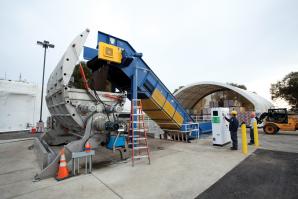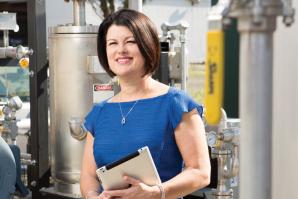In response to global warming, foreign oil reliance and overstressing the nation’s current energy system, policy makers and citizens are backing efforts to produce more safe, clean, renewable energy. But with numerous limitations, implementing green energy has been difficult.
For one, the U.S. electrical grid is antiquated. Built in the 1890s and steadily upgraded over the years, it’s designed to tap into traditional power plants, such as nuclear and coal, but unprepared for renewable energy sources like solar and wind. When the sun is bright or the wind blowing, a surge of power is available but inaccessible.
Reliance on green energy can also have a downside. If utility agencies depend too heavily on variable sources like solar and wind, still, cloudy days would mandate purchasing power from neighboring utilities at a higher cost or employing inefficient power facilities to pick up the slack.
Effectively storing green energy for later use has also been an ongoing struggle, as has efficiently transmitting power from solar and wind plants to consumers. The further power travels, the more energy is lost through “line leakage.”
Meanwhile, the demand for electricity continues to grow. In some neighborhoods, for example, the predicted influx of electric vehicles could tax current grids beyond their capacity.
In the face of these challenges, a handful of startups in the Capital Region are working to improve the reliability and efficiency of the entire power-distribution system.
Sunverge Energy
Sunverge Energy created a network of home appliances that produce and store renewable energy by combining residential solar panels with batteries.
The network, Sunverge Solar Integration System, is the first private, commercial, micro-grid of its kind in California. Described by Sunverge president and CEO Kenneth Munson as a “virtual power plant,” the micro-grid is now featured in a Sacramento housing development at 2500 R St.
The system links via the Internet solar panels and battery storage facilities to each of the 34 homes on the block. Instead of having 2 kW of solar power on a roof plus 10 kW of battery power, Munson says, you now have 34 times that amount accessible.
Sunverge’s micro-grid also stores the energy generated on a sunny day for use during peak hours, saving consumers on time-of-use rate structures 20 to 30 percent over traditional solar panels.
The R Street project is expected to allow homeowners to achieve net zero energy efficiency — producing as much energy as they consume — at an unprecedented rate of affordability, Munson says. By using their own energy during peak-demand hours, Sunverge customers would also reduce stress on the grid, enhancing the reliability of conventionally generated electricity for others.
Smart Grid Billing Inc.
Folsom-based Smart Grid Billing technology uses “smart” electrical outlets to control power to home appliances. The philosophy behind the 18-month-old company is that time-of-use rating scales imposed by utilities agencies to discourage energy use during peak hours accomplish little in changing consumer habits.
“We know that people don’t like to look at the clock to see when they can use the phone,” says CEO Henrik Westergaard, who formerly monitored billing trends in the telecommunications industry. His new venture has employees working across the globe and three operators out of the Folsom headquarters.
When determining the appropriate hour to turn on appliances, Smart Grid Billing measures weather and grid conditions in real time. “So for you as a resident or small-business customer, it’s almost like putting an intelligent timer in front of devices,” Westergaard says.
For example, a customer puts on his profile that his electric vehicle needs to be charged daily by 7 a.m. He can plug it in when he arrives home every evening and forget about it. Meanwhile, Smart Grid Billing will look at various contingents in the grid and identify the optimal time to charge the car so it’s ready by morning. The technology works for an array of appliances including dishwashers, clothes dryers or the defrost cycle on a refrigerator.
“You could just set timers to start at 10 o’clock, but if everyone did that, you would see new peaks popping up,” Westergaard says. “Energy production changes on a minute-by-minute basis, and that’s what we’re trying to assess.”
From the viewpoint of California Independent System Operator Corp., not using 1 MW during peak time is equivalent to producing 1 MW. These savings would flow to Smart Grid Billing, which in turn plans to pass on a percentage of profits to the customer.
“You’re using the same amount of energy as before, it doesn’t cost you anything and we’ll send you a check every month,” Westergaard says. “Our initial plan is to offer it almost for free. You can rent the device, almost like you rent your cable box for a few dollars.”
Customers of utility companies with time-of-use rate structures also would save money on their energy bill. Smart Grid Billing plans to look into storing power, perhaps onto an electric vehicle, and selling it back to the grid. Westergaard wants to start offering the technology to customers sometime next year, but he says a slow regulation process is holding it up.
“We’re hoping it will be quick. We have all the technology today, and there’s so much energy wasted at night,” Westergaard says. “It’s a shame that in a state committed to 30 percent renewable energy we don’t optimize what we already have.”
Draker Laboratories Inc.
Draker Laboratories monitors the flow of power through large-scale, solar-energy production systems to ensure proper functioning. Founded in 1999 in Vermont, Draker is the oldest independent, solar monitoring provider in the U.S. and has deployed more than 400 data acquisition systems in the field.
“If the sun’s shining very brightly, you should expect to get the full power out of your solar power plant,” says Sanjeev Choudhary, the company’s vice president of marketing and business development. If the plant is not functioning at full power, he says, Draker’s hosted Web interface allows solar operators to track system performance and regain full power quickly.
Eventually, this same technology could improve how utility agencies respond to emergencies because they could identify within seconds the exact location of problems within the grid. Historically, the task has required an expensive hit-and-miss system of many linemen exploring various sites to find the problem.
“We are not a smart-grid company per se, but a lot of the technology we have is very similar to what would be used to deploy a smart grid,” Choudhary says.
Draker launched as a solar design and monitoring company, but has since focused specifically on the monitoring and control aspect. Outside investments in 2008 “really accelerated its penetration into the market,” Choudhary says. “We’ve got customers across the U.S., in Canada and Bermuda.”
With an increasing number of California projects, Draker opened a Sacramento office in the fall of 2009 and moved to Davis in July 2011.
The company recently introduced the Solar Prospector instrument to help assess whether a particular site is appropriate for solar. Using meteorological data, the Prospector can pinpoint these sites with far more precision than other satellite systems commonly used for this purpose.
“It collects meteorological data that helps Draker determine what the power output at that location would be,” Choudhary says. “This allows developers to get the project financed … at lower interest rates because the risk associated with power output at that location is greatly reduced.”
Recommended For You

Heater’s Digest
Organic waste to renewable energy gains traction
Children now have logical reasons for not finishing their brussels sprouts at the dinner table. If they’re thrown away, it could be good for the economy and the environment.



